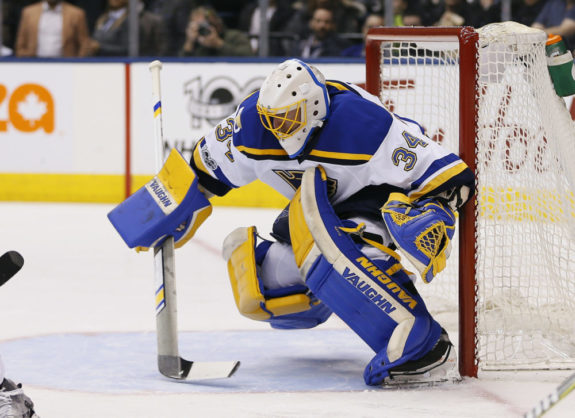![]()
The St. Louis Blues are off to a paltry 2-3-3 start and after a particularly troublesome collapse against the Winnipeg Jets on the road, they are headed home for a seven-game homestand, their longest of the season. While it is far too early to panic, looking at the statistics shows some troubling trends that may point to the team’s larger struggles. Let’s take a dive into five of the most disturbing stats on the Blues right now.
1) Star Forwards Aren’t Scoring
The Blues’ scoring has been uneven, to say the least. David Perron leads the team with five goals, mostly thanks to his hat trick against the Calgary Flames. More frighteningly, Perron, Ryan O’Reilly, and four defensemen (Vince Dunn, Joel Edmundson, Colton Parayko, and Robert Bortuzzo) are responsible for 58.3% of the Blues’ goals this season, as well as 50.8% of all points.

It normally wouldn’t be too concerning for six players to score half of a team’s goals; after all, six players are responsible for 30 of the 34 goals the Toronto Maple Leafs have scored this season. It is disturbing, however, that the Blues’ stars aren’t appearing in the box score very often.
Vladimir Tarasenko has just two goals in eight games, both scored in one performance against the Chicago Blackhawks and Jaden Schwartz, who had .952 points per game last year, has yet to record a goal with just two assists in six games. Moreover, captain Alex Pietrangelo has just one point in eight games after a career-high 54 in 2017-18.
It is, of course, too early to draw significant conclusions but the Blues will not succeed without Tarasenko, Schwartz, and to a lesser extent, Pietrangelo scoring often. It is unlikely that Perron and O’Reilly will continue to score at more than point-per-game pace (though Perron is coming off a career-high season) and the Blues need their star players to produce like star players.
2) Blues Lose Games in the Third
The Blues have struggled to hold a lead in the past, but they’ve put a whole new spin on it this season. Right now, they are being outscored 15-8 in the third period, and that mark is highlighted by their two losses to the Jets when they were outscored 7-2, and by their two overtime losses to the Blackhawks when they surrendering third-period equalizers in each game.
In all but one game against a division opponent, they’ve lost a third-period lead and they’ve lost all four games (though three of those losses were in overtime); that’s three of eight possible points, all lost in the third period. The Blues must shore up their third-period performance immediately and hold on to late game leads.
3) St. Louis Can’t Keep the Puck
Winning teams generally have one thing in common: they control the puck more than their opponent. That’s why Corsi-for percentage (CF%) is such a highly analyzed statistic, a fairly simple calculation aimed at quantifying how much a team controls the flow of play. With CF%, a team wants to control the puck more than 50% of the time and anything lower than that is something of a failing grade.
Only three players on the Blues have a CF% above 50, and only two of them (Pat Maroon and Jordan Schmaltz) have played more than five games. Six players on the team have a CF% below 40, and amongst players with five or more games under their belt, Ivan Barbashev ranks last with a CF% of 34.6.

The individual trends are troubling enough, but the Blues rank sixth-worst in the league in team CF%, which is a more reliable statistic than individual rankings. Below them are weaker defensive teams including the Vancouver Canucks, Ottawa Senators, and the New York Islanders, all considered lottery-pick contenders entering the year.
The Blues are not enforcing their will on the game. It’s a far cry from the style of hockey they played under head coach Ken Hitchcock. While fans understandably grew tired of Hitchcock, his teams dominated the puck, and in 2015-16, when the Blues ventured to the Conference Final, they ranked seventh in the league in CF%.
The drop from a CF% of 52 that year to 46.02 this year suggests that the team has lost its ability to control the flow of play. Whether that’s due to coaching, roster turnover, player failure, or some combination of the three is uncertain. What is certain is that the Blues cannot succeed this year without righting this ship.
4) Most High Danger Goals Against
The two remaining stats are related and they both point to the Blues’ defensive ineptitude. First, the Blues lead the league in high danger goals against. High danger chances (HDC) are calculated by the position and type of shot taken. All shots in close to the net are considered high danger, but a shot from farther out that is immediately after a rebound is also labeled as an HDC.

In the above image, courtesy of naturalstattrick.com, you can see the heat map of the three high danger chances the Jets converted into goals in the opening game of the season. They all come from practically the same spot on the ice, to Jake Allen’s left (blocker side) just outside of the crease. While the Blues goaltending has been the subject of much criticism, it is the responsibility of the defense to prevent attackers from getting to these areas.
And yet the Blues have allowed 15 goals on these high danger chances, two more than the second-worst Calgary Flames, and in one fewer game. It is a clear indication that the defense is not boxing out players and keeping shots manageable for the goaltenders.
5) Worst High Danger Save Percentage
Yet, the goaltenders aren’t above blame in this either. The Blues also rank last in the NHL in SV% on high danger chances. It is hard to pin too much blame on a goaltender when he allows a goal on an HDC. After all, the very definition of these shots is that they are difficult to stop. But the evidence indicates that the Blues’ goalies are worse than any of their peers at bailing out their defense and stopping these difficult opportunities.

Embattled goalie Jake Allen has started seven of the Blues’ eight games this season, and while he’s looked good at times, it’s tough to deny that he’s let in some howlers. His hockey card statistics are ugly (3.64 GAA, .882 SV%) but that’s been pinned primarily on his porous defense. While this is largely fair, Allen has seemed incapable of bolstering that bad defense with tremendous play in net.
Some will want to defend the goaltenders, suggesting it’s entirely on the defense. Others, fed up with Allen’s play in particular, will want to pin all of the team’s struggles on him. Neither analysis is fair. In reality, these statistics on high danger chances suggest that the entire system, defense and goaltending, is to blame for the Blues’ rocky start.
What Does this Mean?
No one needed obscure statistics to tell them that the Blues are scuffling in the early part of the season. These statistics aren’t intended to point out the struggle or pile on the team, but merely to investigate what’s causing the struggle. Overall, they point to a team that has changed significantly over the past few seasons, one that has abandoned the big, physical, and commanding game of the Hitchcock era for a faster, more skilled, and perhaps more reckless style today.

But the Blues are struggling at both ends of the ice. Their star players aren’t scoring, which means they can’t excel at a high-skill game. Meanwhile, their defense and goaltending are consistently breaking down to concede easy goals to the opposition, meaning they can hardly expect to beat their opponents in a war of attrition, either.
The best analysis of these statistics suggests that the Blues do not know their identity. They are torn between speed and size, skill and aggression, talented offense and impenetrable defense. But no man can serve two masters. If head coach Mike Yeo wants this team to be a speed and skill showcase, then they need to start playing like it, and their star players, especially, need to show up. Either way, the coach needs to address his defense immediately, because no amount of skill can compensate for a team allowing as many easy goals as they have.
Difficulties were to be expected with the Blues’ significant roster turnover. Perhaps fans were too confident that it would be smooth sailing all season. But the team needs to address their issues fast, because their division is too good to continue to struggle for much longer.